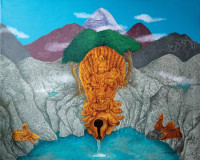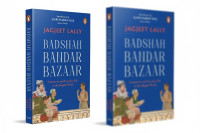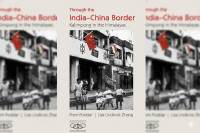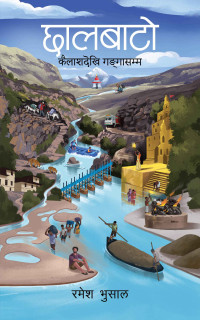Books
'Every translation is a re-interpretation of the original work’
Padma Devkota’s translation of Muna-Madan brings out a new reading of the celebrated poem in the English language, and it does so with a rare creative acuity.
Khem Aryal
We have financial constraints, there are limited venues for publication, and quite often, we lack necessary will to take on the arduous task of translating over writing. It could be easier to author a book of one’s own instead of spending so much time translating someone else’s work. Also, it is fair to say that we have had very few people who are committed to the task of translating with an equal part seriousness and expertise.
In this context, it is a welcome moment when a senior writer takes on the job of translating. Poet and essayist Padma Devkota translating Laxmi Prasad Devkota’s Muna-Madan is one such moment.
Devkota’s Muna-Madan has already had more than half a dozen different translations in English. The first translation was done in 1970 by Madhusudhan Devcota, and since then many others, including Michael Hutt in 1996, have translated the long poem into English.
One may wonder about the need for multiple translations of the same book into the same language. Why would we need one more English translation of Muna-Madan when there are hundreds of worthy works by dozens of Nepali writers awaiting translation?
There must be various reasons for this, and it can be a topic for an academic study of the work. What I find intriguing here is that every translation is a re-interpretation of the original work in a different language, and every translator re-writes the work with his or her own creative power. Padma Devkota’s translation of Muna-Madan certainly does what previous translations do, that is, brings out a new reading of the poem in the English language, and does it with a rare creative acuity, but it also does two more important things: it makes the book available to the English reader in its complete form (none of the previous translations included the parts that Mahakavi Devkota had added to the original text) and it provides a very detailed study of the translated work in the form of a 69-page long introduction.
Mahakavi Devkota had made 10 additions to the original text in 1958 AD, 23 years after the publication of the original work. One of the reasons why the previous translators didn’t translate the added sections could have been the qualms that have been expressed by some critics, in addition to the fact that the translators, like other Nepali readers, must have felt more comfortable with the original text that had been in circulation for more than two decades. Leaving it open to debate whether the additions were really necessary, translator Devkota also states that when it comes to certain additions like Muna’s characterisation and Madan’s reasons for returning home “we wish the poet had done away with these additions or stopped to revise them more carefully” (lix).
However, as the translator points out, the added sections have an even better poetic quality, and they are also an in-depth contemplation on beauty, love, family responsibility and such. Considering what Mahakavi Devkota wanted the book to be with the additions and the quality of those additions, this translation has done a much needed service to Muna-Madan and its readers in English.
Needless to say, the task of translating works like Muna-Madan, works that are deeply rooted in a culture and local speech, is Herculean. A Nepali reader would automatically think of the jhyaure metre when this book comes to his or her mind. The readers in the English language would have no idea of the original meter, but the question always lingers: can this poem be truly translated while leaving the meter aside? Because, the form, the music, itself is a hugely important part of the poem. But what can we do? Translator Devkota explains, “In my translation, besides paying attention to an accurate rendering of the original text, I have also attempted to preserve the simplicity of language for which the work is famous for. I cannot even dream of giving readers a taste of jhyaure in the English language” (lxiii). Readers in English will miss the taste, but the translation rings truly poetic even to the ears used to the Nepali version, despite the translator’s humble confession “although I would have liked the translation to be poetic, too, I must confess that I have arrived nowhere near the goal” (lxiii).
While stating so, I believe, translator Devkota might have been thinking of the famous couplets like “Hatako maila, sunako thaila, ke garnu dhanale,/ saga ra sisno khayeko besh anandi manaleI,” which has been translated as “Bags of gold are like dirt of the hand,/ what shall we do with wealth?/ ’Tis better to live on greens and nettles, my love,/ with peace of mind” (19), and “Chhetriko choro yo pau chhunchha ghinale chhudaina,/manisa thulo dilale hunchha jatale hudaina!” translated as “A chhetri born/ I touch these feet of yours with no disgust./ Man’s measure is his heart, not caste.”
That is one of the limitations of translating works like Muna-Madan. One can only wish that those two languages were not so much apart from each other! Nevertheless, translator Devkota’s poetic sensibility has highly benefited the work in English, and the level of poetic excellence he has achieved in the form of free verse is truly commendable.
This publication also includes the Nepali version of the poem, which makes it easier to those who want to read Muna-Madan in both the languages side by side, and it is an excellent resource for the study of the great work, in addition to just enjoying the poem.
BOX
Muna-Madan
Writer: Laxmi Prasad Devkota, translated by Padma Devkota
Publisher: Adarsha Books, 2018.
Pages: 150
Price: Rs 480




 19.12°C Kathmandu
19.12°C Kathmandu










